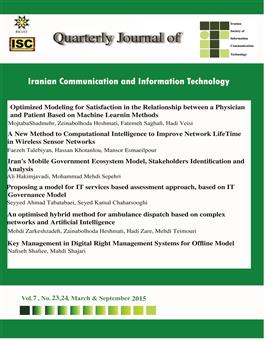Presenting a method based on computational intelligence to improve energy consumption in smart wireless sensor networks
Subject Areas :faezeh talebian 1 * , حسن ختن¬لو 2 , منصور اسماعیل¬پور 3
1 -
2 -
3 -
Keywords:
Abstract :
Recent advances in the field of electronics and wireless communication have given the ability to design and manufacture sensors with low power consumption, small size, reasonable price and various uses. The limited energy capacity of sensors is a major challenge that affects these networks. Clustering is used as one of the well-known methods to manage this challenge. To find the suitable location of the cluster heads, the colonial competition algorithm, which is one of the branches of computational intelligence, has been used. Cluster heads are connected by a three-level model, so that cluster heads with low energy capacity and far from the station are known as the third level and exchange information indirectly with the base station. This increases the lifespan of wireless sensor networks
.W.B. Heinzelman, A.P. Chandrakasan, and H. Balakrishnan, An application-specific protocol architecture for wireless microsensor networks. Wireless Communications, IEEE Transactions on, 2002. 1(4): p. 660-670.
2.R. Min, et al. Low-power wireless sensor networks. in VLSI Design, 2001. Fourteenth International Conference on. 2001: IEEE.
3.I.F. Akyildiz, et al., A survey on sensor networks. Communications magazine, IEEE, 2002. 40(8): p. 102-114.
4.A.A. Abbasi and M. Younis, A survey on clustering algorithms for wireless sensor networks. Computer communications, 2007. 30(14): p. 2826-2841.
5.J.N. Al-Karaki and A.E. Kamal, Routing techniques in wireless sensor networks: a survey. Wireless Communications, IEEE, 2004. 11(6): p. 6-28.
6.L. Subramanian and R.H. Katz. An architecture for building self-configurable systems. in Mobile and Ad Hoc Networking and Computing, 2000. MobiHOC. 2000 First Annual Workshop on. 2000: IEEE.
7.Z. Yong and Q. Pei," A energy-efficient clustering routing algorithm based on distance and residual energy for Wireless Sensor Networks. Procedia Engineering, 2012. 29: p. 1882-1888.
8.W.R. Heinzelman, A. Chandrakasan, and H. Balakrishnan. Energy-efficient communication protocol for wireless microsensor networks. in System Sciences, 2000. Proceedings of the 33rd Annual Hawaii International Conference on. 2000: IEEE.
9.A.M. Jasour, E. Atashpaz, and C. Lucas. Vehicle fuzzy controller design using imperialist competitive algorithm. in Second First Iranian Joint Congress on Fuzzy and Intelligent Systems, Tehran, Iran. 2008.
10.E. Atashpaz-Gargari and C. Lucas. Imperialist competitive algorithm: an algorithm for optimization inspired by
imperialistic competition. in Evolutionary Computation, 2007. CEC 2007. IEEE Congress on. 2007: IEEE.
11. S. Bayraklı, and S. Z.Erdogan. Genetic Algorithm Based Energ Efficient Clusters (GABEEC) in Wireless Sensor Networks, Procedia Computer Science 10, 247-254. 2012.
12.N.Enami, R .Askari Moghadam, K.Dadashtabar, M.Hoseini. Neural Network Based Energy Efficiency in Wireless Sensor Networks: a Survey’, In: International Journal of Computer Science & Engineering Survey (IJCSES) , Vol.1, No.1, August 2010, pp.39-55.
13.L.Shahvandi ,M.Teshnehlab, and A.Haroonabadi. A Novel Clustering in Wireless Sensor Networks used by Imperialist Competitive Algorithm, 2011.

